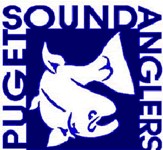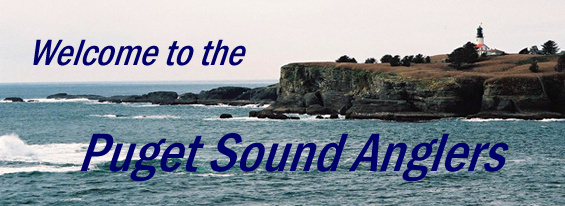|
Cowlitz River
Bank Fishing
| Looking
upriver at the Barrier Dam |
Looking
downriver from the deadline, mid September |
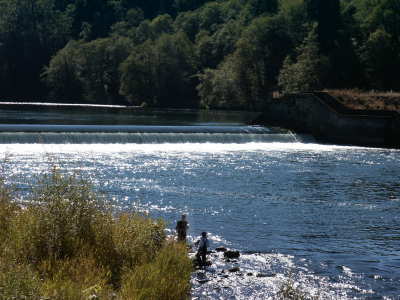 |
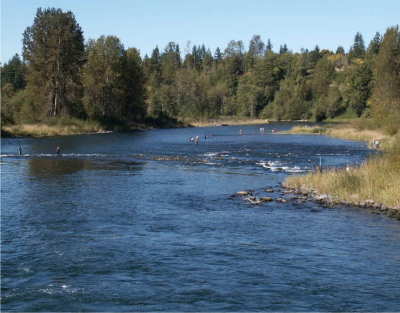 |
Types of fish encountered :
Depending on the time of the year, you will
encounter cutthroat trout, steelhead, Chinook & Coho salmon. Also in
the fall when the salmon are in you will encounter Jack salmon, usually
Chinook. A "Jack" is anything under 24", they usually will
be about 18"+. It has even been reported of a sturgeon pulled
from the Cowlitz at the mouth of the Toutle.
Where to go :
The most popular spot for bank fishing the
Cowlitz is probably below the barrier dam salmon hatchery near Salkum. Go
east on Hiway 12 from I-5 & as you enter Salkum turn right on the Fuller
Rd. Go to the intersection of the Spencer Rd & turn left. Not
far the road forks & straight ahead is dead end, turn right & go down
the hill to the hatchery & dam. Parking
is plentiful, good restrooms, picnic tables & a boat launch here.
If the fish are not biting you can take the grandkids up to the wire fenced
intake to the hatchery fish ladder & look over the side possibly seeing fish milling
around there before going up the fish ladder into the hatchery.
Downstream off the Spencer Rd. 6 miles is the Trout Hatchery.
Fishing is accessible along the bank above & below the launch. Another popular spot that is accessed with a
well defined trail heading downstream from the Trout Hatchery launch parking lot, is the mouth of Blue
Creek & is a good fish catching location if you like company.
| The combat
fishery a the mouth of Blue Creek |
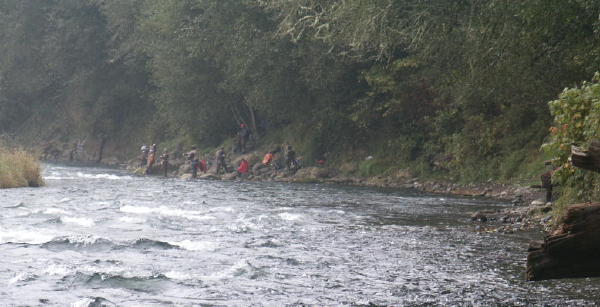 |
Farther downstream a few more miles is a boat launch at the Mission bar & fishing is possible off the
banks here.
Farther yet just west of the I-5 bridge is another public launch, again with bank
access.
Then farther yet the mouth
of Olequa Creek and farther yet would be the mouth of the Toutle. All of
these are accessible to the public. As with any river it may be best to go
there & take a look when the water is low in the summer. Make a
note the
locations or take digital pictures of the large rocks, gravel bars, holes, logs/stumps, etc. This
will give you some idea of where to fish later when the water is higher &
the fish move into the river system.
These boat launches are shown & described
in another article "Boat launches of the Cowlitz River".
There is usually good public access places to bank fish at all these launches.
In the picture on the left below, the fishermen in the
foreground have hooked 3 Chinook from the line of other fishermen & have brought
their fish downstream into the shallow pool to bank land them in the location
that is normally occupied by plunkers.
| Looking
upriver from the Barrier Dam launch parking lot |
The Cowlitz
River with the Toutle River entering on the right. |
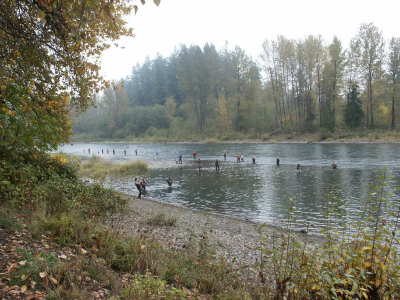 |
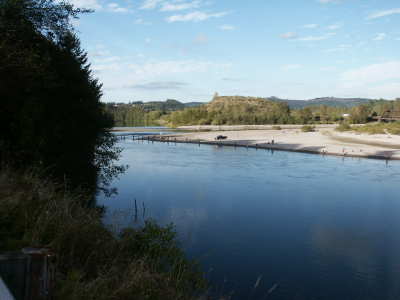 |
When to go : There seems to be a run of something there
most of the year. Steelhead would be the most sought after
specie. Salmon would probably be next, with Chinook coming in the spring
& the fall. Coho salmon will show about the 1st of October.
Cuthroat trout will be there when the salmon are spawning.
Different types of fishing-
Plunking with bait/lure
Spin-N-Glo
/ Oakie / Corky
Casting
Spoons/spinners
Oakie / Corky
Drift Fishing/casting
Jigs
Bobbers used
with bait/jigs
Plunking : This
method is a rather laid back way to fish & is a term used for still fishing from either the bank or anchored boat, usually with bait near the bottom. The main bait of choice is usually cured salmon eggs.
| Typical
Plunking set-up |
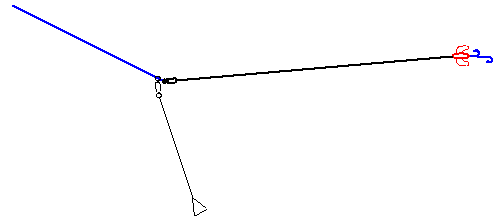 |
One method used by many is to use a Spin-N-Glo as an attractant in a size from size 2 to 0. Use a 30" snelled egg tie leader & thread a Spin-N-Glo on.
This will be your leader to the bait. You can then either use just the Spin-N-Glo alone or with eggs.
Preferred colors for the Spin-N-Glos seem to be chartreuse & or orange.
You can attach this leader to either a 2 or a 3 way swivel, depending on your preference as to how to attach the sinker.
If you want it as a slider, use the 2 way & put the upper swivel eye on the mainline slider above your terminal swivel or snap.
Some fishermen prefer to use a sturgeon slider instead of the 2 way swivel.
If however you want to run the sinker on a dropper, then use the 3 way & tie it as your terminal end of the mainline.
The idea is to use a heavy enough sinker to hold the lure on the bottom.
Droppers to the sinker should be 8-12”, & of a lighter leader material so it can be broken off if the sinker snags up, without loosing your lure.
Sinker weight will vary with the current, but usually from 2 to 4oz. is
sufficient.
You probably should make up complete spare setups, as usually it is easier to tie these up at home than on the river.
The fish tend to concentrate near the shore. This river is not a small
river & you may have to cast farther to reach your intended
area. However cast of 40' or so is a long cast, more like 15 to 20'
may
be a better distance. You may have to cast a little farther so your
lure rests where you want it, as you can reel it in to the desired
location. Plunking works best in pools of slower moving water, or if
possible at the seam between the faster water & the edge of the pool's
slower water. The Chinook will come up and mouth a plain Spin-N-Glo, so you have to be ever watchful of the rod tip.
One place to look for would be the slower moving water directly upstream from a
riffle.
Most plunkers use a rod holder set into the river bank. In this
gravel, you may need a large hammer to drive it in. You should then consider getting a little bell to attach to your rod tip as a signaling device, as many times you may get complacent & not be attentively watching the rod tip 100% of the time.
Then there is the question of scent. Do I use it or not?
Well, salmon & steelhead have a very good sense of smell. It sure does not hurt to add some egg
scent as an extra attractant. Another thing is that many use a few
inches of yarn along with the eggs. This can add a color, but more
importantly it serves a dual purpose of supplying a source for your scent to
soak into, and if the fish just bites but lets go quickly, it may possibly get
it's teeth tangled in the yarn enough to not let it get away before you can set
the hook.
One of the easiest way to learn anything is to watch other fisherpersons on the river.
You might even ask them, most may even be glad to share what they know.
Binoculars can also be useful.
| Plunkers
between the Barrier dam & the launch, summer |
Same
location as on left, but in mid October |
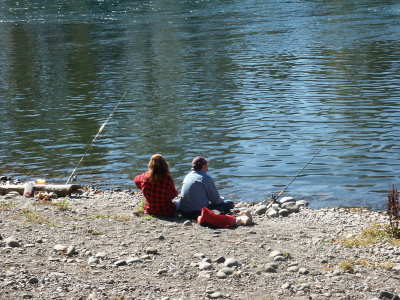 |
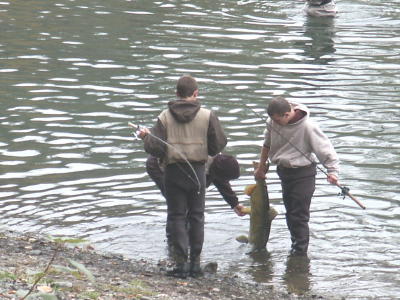 |
Casting :
This will vary depending on where you are & the water/depth conditions.
Usually this will consist of casting a gob of eggs, either alone or in
conjunction with a Corky or Spin-N-Glo. You could use basically the same
rigging as for plunking, but with a lighter sinker. Others will cast
spinners. Here you cast upstream enough so as to let your lure reach
bottom about directly out from you. Let it swing in an arc & come
inshore below you.
On this or any river that has the potential of many
fisherpersons sharing the river bank, to keep from getting tangled with your
neighbor, if you are all strung out along the bank, the lower person casts
first, with the next person upstream following. The farthest one upstream
in the row will be the last to cast. If you miss your turn because
you are re-baiting or attending your gear, tough. You have to wait until
the rotation comes around to you again.
If someone gets a fish on, then the others may have to pull
their lines in or allow the fisherman with the fish on to negotiate over or
under their line to create less a chance to tangle the fish & possible lose it
for the fisherman. If it is a large fish, head downriver to where
you can being it to shore in calmer water. When it comes your turn with a fish on, they will
do the same for you.
Drifting : Here
the lure may also be a lure/egg combo, but using a lighter sinker that will
allow the lure to bounce along the bottom. Another version of this
method would be using a bobber. Here the bobber & sinker is adjusted
so the lure will be drifted about 12" off the bottom. The
bobber needs to be sliding on the mainline & be able to adjust it to
the river depth & current at your current location. This lure can be
eggs or a small jig. With this technique, you cast upstream at
a bout a 45 degree angle, and take up the slack (reel in) slightly keeping the
lure just bouncing along the bottom. When the line & lure is straight
below you, you reel in & start over.
The protocol is the same here as for casting if many are
lined up, unless you happen to find a day or early enough in the morning when
you can walk downstream with the bobber.
Remember that snagging is not legal & in freshwater it is
illegal to possess any fish hooked anywhere other than inside the mouth on on
the head.
Landing Net?
: If you are alone & casting,
or drifting & may well be moving around on the gravel bars, some fishermen will
fashion a holding device for the landing net into a backpack with the net bag in
the air above their head. If you however are fishing with a friend, who
can maneuver & retrieve a net you have on the shore, that is another option.
The plunkers usually are fishing calmer water & can just beach the played out
fish onto the shore.
Tackle-
Reels- Most bank fishermen will
probably use a spinning outfit, as it seems to be easier to cast farther that is
needed in this larger river. What ever reel you decide, buy these best you
can afford & be sure it has a GOOD drag system, as you do not have the luxury of being in a boat
that you can pick up & chase a large fish if it decides to run. You
also need a large enough reel to accommodate about 200 yards of 20 or 25# line.
Rods- A 8' 6" medium weight
salmon/steelhead rod will probably be seen mostly, as it can be used well for
cutthroat, or Chinook. Some of the dedicated jig fishermen use a
10-11' rod.
Line- Line will possibly vary depending
the time of the year & what is in the river. But normally a 12-15#
monofilament will do. If Chinook can be mixed in the potential bag, then maybe up to
20-25# could be
used.
Information / Gear :
There are 2 good locations that you can purchase tackle that is used here,
plus find out what & where the action is.
(1) Fish Country Sports Shop (360-985-2090) on south side of
Hiway 12 between Ethel & Salkum. This small store is run by a
husband & wife team & are friendly, will give advice to the novice, has bait,
rods, tackle, a free map of the Cowlitz & willingly offer advice.
Don't cut Kay short if Frank is not there as she is a wealth of information on
the river. They open at 6 AM for your convenience.
(2) Barrier Dam RV & Tackle which is located on the
Fuller Rd & is the last place on the left before you get to the Spencer Rd.
intersection going to the barrier dam. It is owned by Don Glaser who is
very much involved with The Friends of the Cowlitz. This business
can also be helpful with gear & information.
Observations :
There is usually a decent fall Coho run in this river. However many
fishermen have passed on the information that they have lock-jaw & are not
biters. So no matter how many fish the WDFW allows you to retain in a good
year, it is really immaterial as they are only supplying you opportunity, not
reality.
Copyright © 2004-2006
LeeRoy Wisner All Rights Reserved
Last Updated 10-29-2006
to
contact the author click here
|
